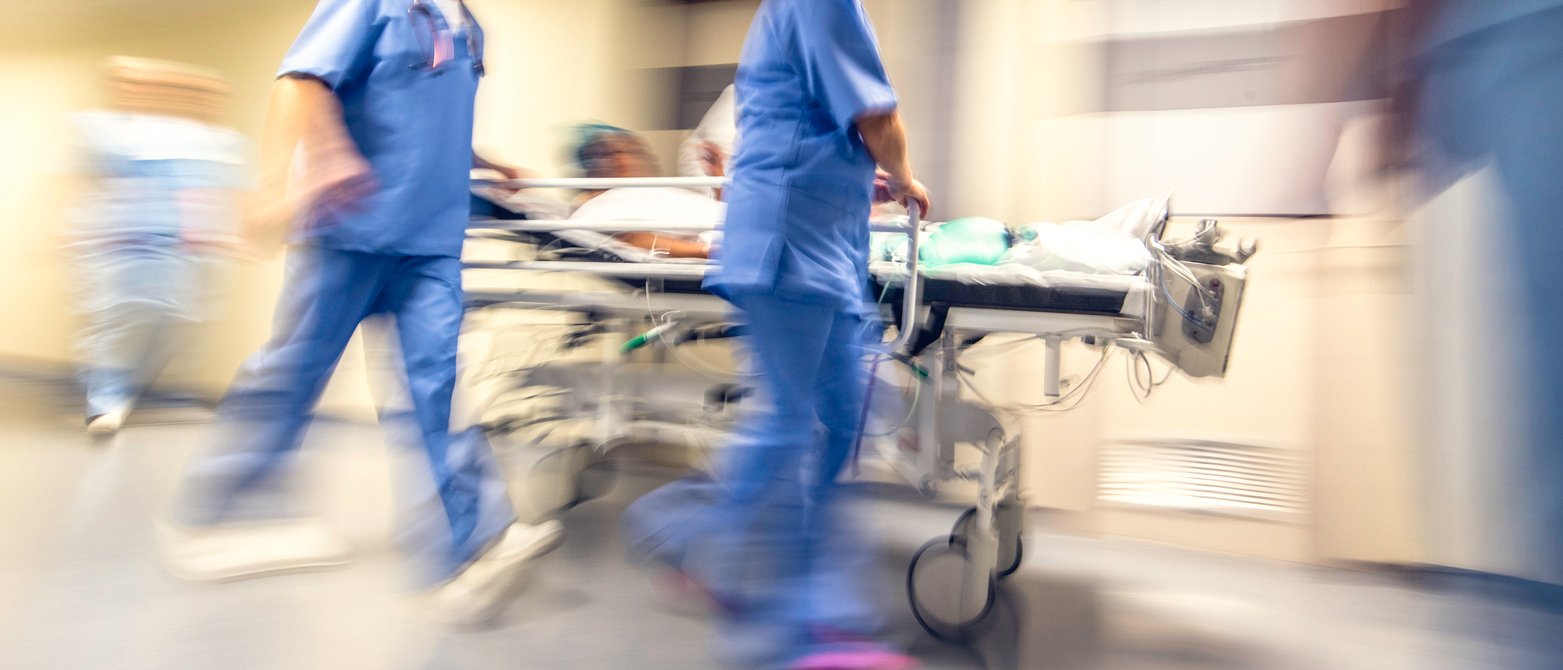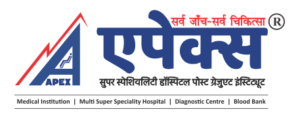
POLY TRAUMA & EMERGENCY WING
Life Saving Referral & Research Hospital
The hospital is serving people with safe hands by proving its Poly Trauma Center. Hospital is providing 24 hours emergency and trauma care is geared to treat all kinds of medical and surgical emergencies including poly-trauma with the most advanced equipments. The emergency is manned by well trained doctors who follow the ACLS and ATLS protocols.
The emergency is divided into triage area where all the patients are first seen and stabilized and an observation area for patients who need to be kept in the hospital for a few hours. The emergency care is backed by consultants from all specialties and super-specialties, round the clock and supported by skilled paramedics.
The pre-hospital care is done by a fleet of fully equipped ambulances manned by paramedical personnel who are trained in basic life support and basic trauma life support.
The National Emergency Network has provided Apex Hospitals an Emergency Number – 9415304102 , to help people have an easier access to medical care during any kind of emergency.
The Fractures of the Upper Limb
Clavicle fractures are one of the most common fractures seen in outpatient department they occur due to fall on outstretch hands, RTA. Most of the times clavicle fractures are treated conservatively. The surgical treatment is indicated in patients with tenting of skin over the fracture site, open fractures, nonunion and if neurovascular deficit is present. Patients who are treated conservatively will require 3 weeks of immobilization followed by shoulder strengthening exercises. The surgical treatment is in the form of plate fixation and immediate mobilization of the shoulder joint.
Proximal humerus fracture are common both in young and elderly patients, which occurs due to either trivial fall or due to RTA. In all age groups the proximal humerus fractures are treated by open reduction and internal fixation with locking plate through delto pectoral approach. The aim of fixation is to achieve good range of movements and quick recovery. The most common complication encountered are stiffness of the shoulder for which prolonged physiotherapy is advised. Other complications include avascular necrosis of the humeral head which may require joint replacement surgery at a later date.
Simple fractures of shaft of humerus are commonly treated by Open reduction and internal fixation through delto pectoral approach, which is a gold standard method followed till now. In situations of segmental comminuted fractures of humerus, minimal invasive surgery is indicated in the form of interlock nailing. Fixation of humerus fractures gives us the opportunity to mobilize the shoulder and elbow joint early and stiffness is avoided. All the patients are immediately subjected to physiotherapy so that the stiffness the joints is avoided. However, the most common complication in humerus fracture fixation is radial nerve palsy which usually recovers over a period of time.
Fractures around the elbow are notorious fractures which results in stiffness of the elbow which is very difficult to treat. Most common mode of treatment for distal humerus fractures is open reduction and internal fixation with contoured locking plates through posterior either Campbell’s approach or olecranon osteotomy. Extra articular distal humerus fractures are treated with either special locking plates or Ender’s nails and additional plate fixation. After surgery the patients are advised immediately to do physiotherapy in the form of active and passive elbow mobilization.
The fractures of the radial head, olecranon and coronoid process and associated elbow dislocations are constituted to the group of terrible tried. The results of fixation of these fractures are not encouraging to the surgeon, since the result in severe stiffness of the elbow. The radial head fractures are fixed with either Herbert’s screws or contoured locking plates. Olecranon fractures are usually treated with tension band wiring principle. The coronoid process is fixed through medial approach using fiber wires, suture anchors. The stiffness of the elbow which is a commonest problem is treated by open arthrolysis through posterior approach.
Fractures of the forearm are considered as intra articular fractures and hence radius and ulna fractures are best treated by open reduction and internal fixation with dynamic compression plates. The radius fracture is approached by volar Henry’s approach and through dorsal incision ulna fracture is exposed and fixed with plates. Forearm fractures are immediately mobilised after fixation and in comminuted fractures iliac crest bone grafting is advised.
Distal radius fractures are named as Colles fractures if they occur in elderly patients. Colles fractures are treated usually by closed reduction and either plaster application or percutaneous k-wire fixation. The wrist joint is immobilised in plaster for a period of 6 weeks followed by rigorous physiotherapy. The most common complications are wrist stiffness, pintrack infections, malunion, dinner fork deformity and shoulder hand syndrome. Wrist stiffness and shoulder hand syndrome are best treated by aggressive physiotherapy. Young patients usually present with comminuted fractures and volar bartons fractures which are treated with plate fixation through volar approach.
Fractures of scaphoid is the most commonest fracture seen in the wrist. Undisplaced fractures are usually treated with scaphoid cast application for a period of 3 weeks. If the fracture is displaced, they are treated by either percutaneous or open Herbert’s screw fixation. The most common complication seen in scaphoid fractures is avascular necrosis and nonunion which usually necessitates the need for repeated procedures. Other common injuries around the wrist are perilunate dislocations which are treated by open reduction and K-wire fixation through volar and dorsal approaches. Wrist stiffness is common after these procedures which require aggressive physiotherapy.
Apex Hospital’s is a tertiary referral centre and manages all complicated open fractures of upper limb. Since Coimbatore is a hub of many textile industries, patients usually presents with severely crushed and mangled extremity. They need multi disciplinary approach which includes anaesthetic, plastic and orthopaedic team available round the clock inside the hospital premises which makes us to take care of this injuries effectively. The main key element of success in this mangled extremity management is immediate effective debridement and primary plate fixation for the upper limb fractures. The soft tissue defects are usually treated either by free flaps or abdominal flap cover. The bony defects are usually reconstructed by free fibula graft.
Pelvic fractures often result due to a very high velocity injuries like road traffic accidents, fall from height. Most commonly they are associated with either upper limb or lowerlimb injuries or both. Patient usually presents in a state of shock characterized by hypotension, tachycardia, difficulty in breathing and they can be associated with chest or abdomen injuries. They need immediate proper resuscitation in the form of I.V. fluids (colloids & crystolloids), emergency stabilization of pelvis with external fixator. Pelvic fractures are often associated with high mortality and morbidity. All the patient with pelvic injuries are subjected to whole body CT scan to rule out other systemic injuries. Once the patients general condition is stabilized, both anterior and posterior ring stabilization is done in the form of plate fixation. After surgery patients are mobilized after a period of 6 weeks.
The Fractures of the Lower Limb
The neck of femur fractures are common in elderly age group due to osteoporosis and trivial fall results in fractures. They are best treated by joint replacement surgery in the form of either hemi or Total hip arthroplasty. The main aim is to mobilize the patient as early as possible so that we can prevent prolonged bed ridden complications like hypostatic pneumonia, bedsores, sarcopenia, decreased cardio respiratory reserve. On the second day of surgery patient is mobilized with full weight bearing with walker support.
The neck of femur fractures in young patients usually results due to high velocity injury. In young patients the femoral head is preserved and stabilized with cancellous screws. If the patient presents late with neck of femur fracture, treated with valgus osteotomy, bone grafting and DHS fixation.
Trochanteric fractures results due to trivial fall in elderly patients, high velocity injury in young patients. In all age groups, trochanteric fractures are stabilized with either DHS or proximal femoral nail. If the trochanteric fracture is found to be grossly comminuted in elderly patients, they are better treated with cemented bipolar hemiarthroplasty. All the patients are mobilized immediately on second day after surgery with full weight bearing walking.
Femur fractures often results due to high velocity injuries, especially RTA. Subtrochanteric fractures are treated with open reduction and reconstruction nailing. Shaft fractures are well managed with inter locking nailing, distal third femur are managed well with locking compression plate and retro- grade nail too. Patient who underwent nailing are mobilized immediately from the 2nd day onwards with full weight weight bearing. Those who are plated are mobilized early with weight bearing after 6weeks. Most dreaded complication is ARDS- Adult respiratory distress syndrome, hence femur fractures need careful evaluation especially in youngsters.
Knee injuries are very common injuries mainly due RTA, fall , sports activities etc. patellar are the most common among , which are well managed with k- wires , circlage wire, tension band wiring by which extensor mechanism is well maintained and mobilized from 2nd day with full weight bearing. Ligaments and meniscal injuries are in young age group following sports and fall. Meniscal can also happens in elderly following minor trauma and it aggravates degeneration. Ligaments and meniscal injuries can be well managed with key – hole surgeries by Arthroscopy and patient can be mobilized very early from the 2nd day onwards. Articular bony injuries are managed with locking plates, cancellous screw fixation with which joint mobilized faster and regains movements much earlier.
Most commonly occurs due to high velocity injuries like RTA in youngsters and following a trivial fall in the elderly, these are managed with inter – locking tibial nailing , Expert tibial nail, locking plates and buttress plate especially for tibial condyles. Distal tibial fractures are know for its complication due to poor vascularity can also be managed well with nail and locking/ Dynamic compression plate.
Ankle fractures are very common both in younger and elderly age group, mainly following a simple twist and fall, which needs accurate reduction due to its articular involvement. It can be fixed with k-wires , malleolar screws, tension band wiring and plate, hence , patient can be mobilized earlier.
Foot injuries are very common following a trivial fall , fall from height , RTA – crush injuries etc. These can be managed well with small plates , k-wires and screws. Fractures like phalanges are usually treated with strapping.
Talus and calcaneum happens following fall from height, Talus can be fixed with cancellous screw and calcaneum can managed conservatively if without much displacement, if displaced needs k-wires, calcaneal plates.
What our patients are saying
very day we strive harder to deliver a great patient experience which is not just the treatment but also your overall experience at any of our facilities.
MAKE AN APPOINTMENT NOW!
